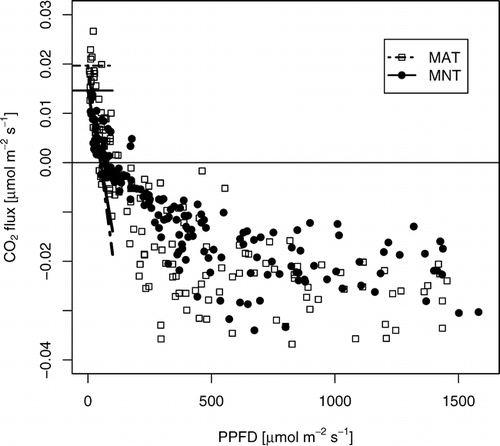Figures & data
FIGURE 1. Light response of moist acidic (MAT) and moist nonacidic (MNT) tundra. Ecosystem respiration (thin horizontal lines) is determined from the intercept of a linear regression (thick lines) to the data at PPFD <50 μmol m−2 s−1. Data recorded when the wind direction was from the sector 330–340° (MAT) or 300–305° (MNT) were excluded. The regressions (best fit ± standard error of fit) for MAT and MNT are Fc = (0.020 ± 0.003) − (0.00038 ± 0.00009) PPFD (r 2 = 0.46), and Fc = (0.015 ± 0.002) − (0.00029 ± 0.00006) PPFD (r 2 = 0.52), respectively

FIGURE 2. Comparison of average diurnal cycles of energy (Rn, G, H, LE) and CO2 fluxes, and surface-soil temperatures (Tsoil). Measurements were obtained during a 9-d period (21–29 June 1995). Open circles, solid lines: moist nonacidic tundra; filled squares, dashed lines: moist acidic tundra. Alaskan daylight savings time (ADT) is UTC−8 h. Only data records measured simultaneously at both sites were considered. Vertical bars denote ± 1 standard deviation

TABLE 1 Comparison of properties of moist acidic (MAT; Site 95-4) and moist nonacidic tundra (MNT; Site 95-3) types, average ± standard error
TABLE 2 Characteristics of air temperature measured at the Toolik Lake LTER site (68°38′N, 149°36′W, 760 m a.s.l.) during the period of flux measurements and the preceeding month with respect to the station's 16-yr mean, 1988–2003.a
TABLE 3 Characteristics of the microhabitats where soil heat flux plates were inserted at 5 cm depth and soil temperatures measured the average of the top 5 cm. The weights were used to obtain a weighted average in the computation of ground heat flux for each site
TABLE 4 Daily sums of energy and CO2 fluxes for moist acidic tundra (MAT) and moist nonacidic tundra (MNT). R n: net radiation; H: sensible heat flux; LE; latent heat flux; G: ground heat flux; F CO2: CO2 flux. The slopes of G and F CO2 differ significantly from 1.0 (95% confidence interval, corrected for serial correlation)
Table 5 Daily sums of carbon dioxide fluxes for moist acidic tundra (MAT) and moist nonacidic tundra (MNT) derived diurnal data. The sign convention is positive for fluxes from the vegetation to the atmosphere